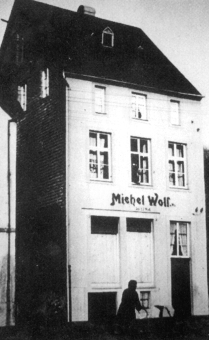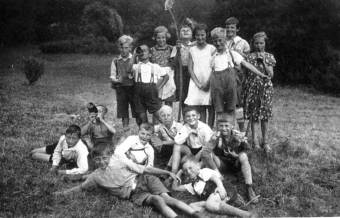Manfred Wolf (*1924)

© Manfred Wolf

© Manfred Wolf
“I hope that people will see what it really was like, what Hitler did, what the Germans did, even if some of them might have not gone along with it, some of them didn’t even know. […] Normal persons… people will not accept something like this.”[1]
Manfred Wolf was born in Merl on the Mosel River on July 15, 1924. His father, Eduard, had a men’s clothing shop there, and the family included Manfred’s mother, Rika (née Franke), and grandmother, Johanna. His childhood as the only Jewish child in town was characterized by playing games with his friends, contact with the neighboring craftsmen, and swimming in the Mosel. The photo was taken on a school trip. The family kept a kosher home and celebrated Shabbat, and in addition, like all his friends, Manfred attended the Catholic kindergarten. As of 1933, his father’s barber refused to keep shaving him, and the Hitler Youth sang anti-Semitic, defamatory songs in front of their house. Manfred’s mother died in a fire in 1935, and his father remarried one year later. After November 9, 1938, Eduard Wolf was sent to the Dachau concentration camp, and his shop was totally destroyed. Released, he sent Manfred to a Hachshara camp near Cologne in 1939 to train as a mechanic and prepare for emigration.
In 1942, his father and stepmother were to be deported, and Eduard asked Manfred in a telephone call whether he would be coming along. The son suspected what this meant, and declined. He never heard from his parents again. From the Paderborn labor camp, where Manfred went after Hachshara was banned in 1941, all the young people were deported to Auschwitz in 1943. There Manfred and a few other young men were taken to the Buna/ Monowitz concentration camp. He had to do forced labor at the I.G. Farben construction site: at first under extremely harsh conditions in the cement detachment, where he injured himself after a few days and then entered the infirmary. After his release, he was put in a somewhat better work detachment. His Kapo, Harry, took him along to the Sosnowitz camp, where he had to work as a roofer and in a munitions factory. The death march in January 1945 led Manfred Wolf first to the Mauthausen concentration camp and then on through Austria until he finally reached the Gunskirchen concentration camp, a subcamp of Mauthausen, where he was liberated by the U.S. Army. He made his way on foot to Salzburg, and from there British Palestine units took him from Genoa to Haifa.
He lived with his uncle and worked for the air force as a mechanic. In 1951, he decided to return to Germany, to take possession of his parents’ home again. In Cologne he met Sonja, a Zionist who had escaped from the “Eastern Zone.” After knowing each other half a year, they married; their daughter Rika was born in 1952. The Wolfs wanted to go to America, and on April 5, 1954, they arrived in Erie, PA. Their son Eddie was born there. Today Manfred Wolf lives in Los Angeles. He openly confronts anti-Semitic outbursts: “Now, I fight back.”
(SP; transl. KL)
















